What does psoriasis look like? Psoriasis is an autoimmune disease that does not have a cure. This chronic disease affects mainly skin with symptoms such as red, scaly rashes appearing on the scalp, elbow, navel, knees, around and inside the ears, buttocks, in the genitals and other areas. These symptoms tend to be persistent, but there are times when they improve and worsen. While there is no cure, the condition can be controlled with treatment. Treatment of psoriasis is aimed at slowing down skin cell growth and providing relief to the skin. Lifestyle measures are also essential in controlling the condition. Applying nonprescription cortisone cream is advised and the patient should avoid long exposure to direct sunlight.
What does psoriasis look like by Type?
1. Plaque Psoriasis
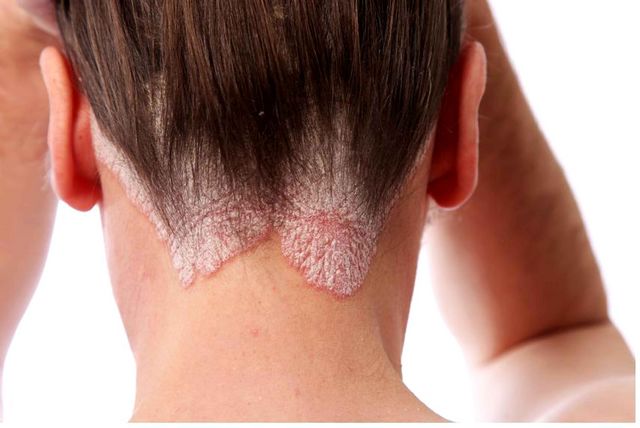 This is the most common type as it affects approximately 80% of psoriasis patients. Plaque psoriasis mainly affects the knees, elbows, scalp and lower back. The condition is characterized by red scaly patches on the skin and these scales tend to be thick with a white or silver layer. Patients develop this type of psoriasis due to various triggers, but there have been cases of the condition being linked to genetics.
This is the most common type as it affects approximately 80% of psoriasis patients. Plaque psoriasis mainly affects the knees, elbows, scalp and lower back. The condition is characterized by red scaly patches on the skin and these scales tend to be thick with a white or silver layer. Patients develop this type of psoriasis due to various triggers, but there have been cases of the condition being linked to genetics.
2. Guttate Psoriasis
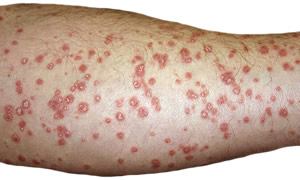 This is the second most common type of psoriasis and it is characterized by small, red rashes. The rashes which appear as spots mainly form on the limbs, torso, scalp and the face as well. While they are not as thick as the rashes experienced with plaque psoriasis, they could transform into the most common psoriasis over time. This type of psoriasis is most common in childhood and young adulthood and it can be resolved for a long time with treatment.
This is the second most common type of psoriasis and it is characterized by small, red rashes. The rashes which appear as spots mainly form on the limbs, torso, scalp and the face as well. While they are not as thick as the rashes experienced with plaque psoriasis, they could transform into the most common psoriasis over time. This type of psoriasis is most common in childhood and young adulthood and it can be resolved for a long time with treatment.
3. Inverse/Flexural Psoriasis
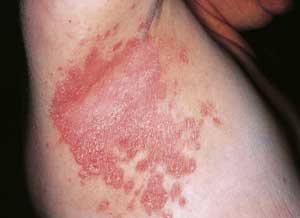 Flexural psoriasis mainly affects arrears where the skin folds including: the groin area, armpits and under the breasts. With this type, the skin appears very red, smooth and shiny as well. Most patients who suffer from this type of psoriasis tend to have another different form of the disease. Due to the nature the skin areas that are affected, the condition can be very irritating. There are a number of topical treatments that are effective in treating the condition.
Flexural psoriasis mainly affects arrears where the skin folds including: the groin area, armpits and under the breasts. With this type, the skin appears very red, smooth and shiny as well. Most patients who suffer from this type of psoriasis tend to have another different form of the disease. Due to the nature the skin areas that are affected, the condition can be very irritating. There are a number of topical treatments that are effective in treating the condition.
4. Pustular Psoriasis
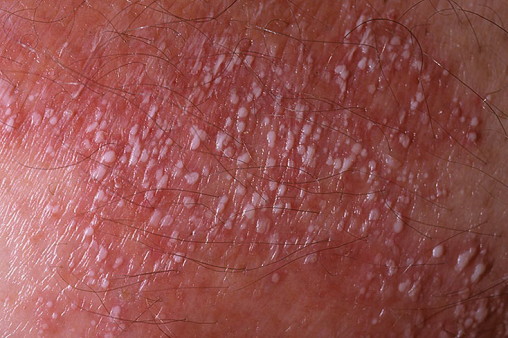 With pustular psoriasis, the skin forms small red, puss-filled pustules which require medical treatment. The skin also develops scales and this condition may affect the hands, feet or even cover the entire skin. There are three varieties of this disease and these are acropustulosis, palmoplantar pustulosis and zumbusch psoriasis. These three types come with different symptoms and different levels of severity. Some patients will experience recurring periods of the symptoms and remission.
With pustular psoriasis, the skin forms small red, puss-filled pustules which require medical treatment. The skin also develops scales and this condition may affect the hands, feet or even cover the entire skin. There are three varieties of this disease and these are acropustulosis, palmoplantar pustulosis and zumbusch psoriasis. These three types come with different symptoms and different levels of severity. Some patients will experience recurring periods of the symptoms and remission.
5. Nail Psoriasis
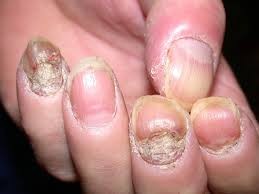 Nail psoriasis is not yet officially categorized as a form of psoriasis, but it is quite common affecting about half the patients suffering from other forms psoriasis. The condition can be confused with a nail fungal infection as it causes nail discoloration, pitting, grooves, crumbling nails, discolored patches and spots visible under the nail as well as skin thickening under the nail. There is no cure for this condition, but various treatments are available and these help improve the condition of the nails.
Nail psoriasis is not yet officially categorized as a form of psoriasis, but it is quite common affecting about half the patients suffering from other forms psoriasis. The condition can be confused with a nail fungal infection as it causes nail discoloration, pitting, grooves, crumbling nails, discolored patches and spots visible under the nail as well as skin thickening under the nail. There is no cure for this condition, but various treatments are available and these help improve the condition of the nails.
6. Scalp Psoriasis
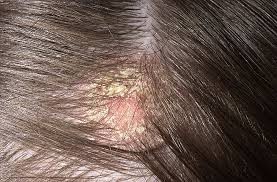 Various types of psoriasis appear on the scalp causing dandruff. Others are however more irritating causing a noticeable scaly patch on the scalp which can be itchy and painful. This form of psoriasis may appear as a large patch or in small patches. Scalp psoriasis can make it difficult for the patient to have proper hair hygiene due to scalp infections and irritation. The condition may bring about further conditions, such as hair loss and social stress. There are topical treatments used to relieve the condition.
Various types of psoriasis appear on the scalp causing dandruff. Others are however more irritating causing a noticeable scaly patch on the scalp which can be itchy and painful. This form of psoriasis may appear as a large patch or in small patches. Scalp psoriasis can make it difficult for the patient to have proper hair hygiene due to scalp infections and irritation. The condition may bring about further conditions, such as hair loss and social stress. There are topical treatments used to relieve the condition.
7. Psoriatic Arthritis
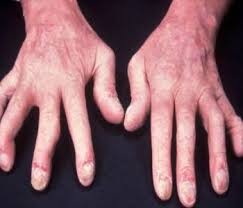 Psoriatic arthritis is painful and as the name suggests, it affects the joints with the most severe form affecting the hands. In addition to inflamed, scaly skin, psoriatic arthritis causes pitted, discolored nails and the swollen, painful joints that are typical of arthritis. This type of psoriasis affects approximately 30% of patients with psoriasis and again, there is no cure for the disease. However, some patients will experience periods of remission and this is often due to exercise and arthritis treatment.
Psoriatic arthritis is painful and as the name suggests, it affects the joints with the most severe form affecting the hands. In addition to inflamed, scaly skin, psoriatic arthritis causes pitted, discolored nails and the swollen, painful joints that are typical of arthritis. This type of psoriasis affects approximately 30% of patients with psoriasis and again, there is no cure for the disease. However, some patients will experience periods of remission and this is often due to exercise and arthritis treatment.
8. Erythrodermic Psoriasis
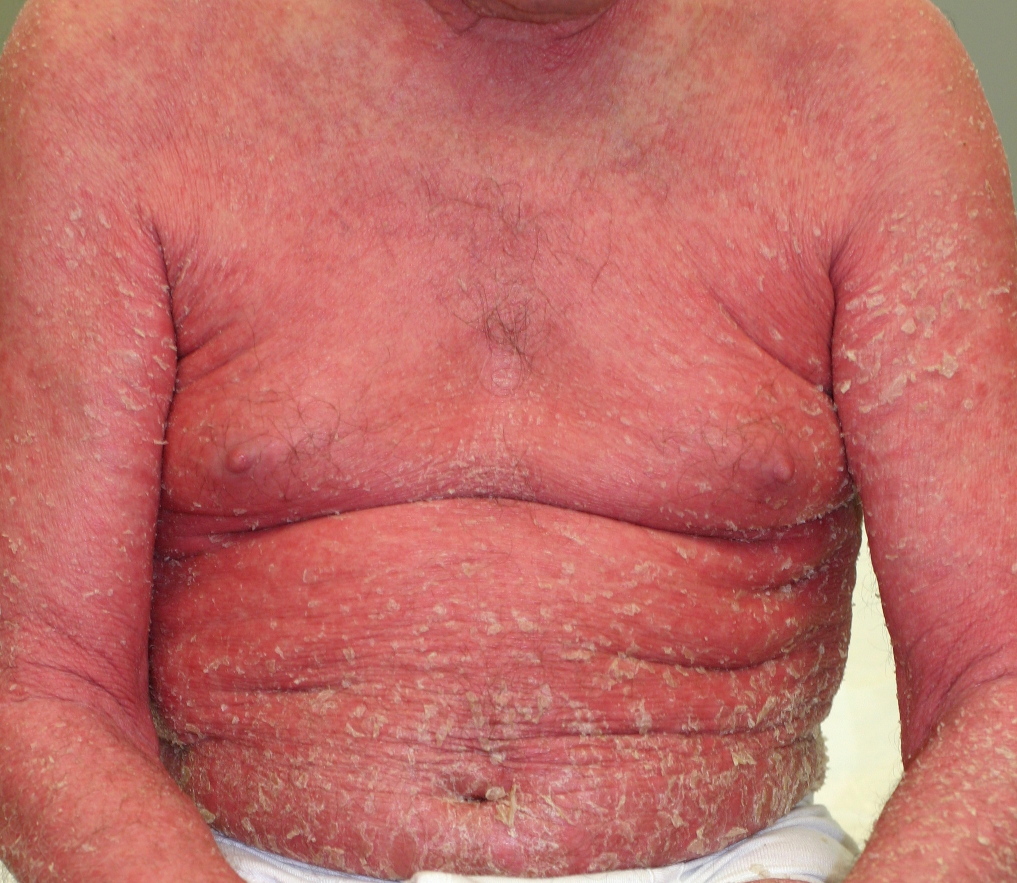 This is the rarest type of psoriasis, but one that is quite serious. The condition is accompanied by severe burn-like symptoms on the skin and these could cover a large part of the body. Unlike other types of psoriasis, larger skin shedding occurs and this can be very painful. This type of psoriasis can be caused by poor management of plaque psoriasis or develop from pustular psoriasis. Other possible causes include major stress, sunburns, alcoholism and when the patient abruptly stops using medication for systemic psoriasis.
This is the rarest type of psoriasis, but one that is quite serious. The condition is accompanied by severe burn-like symptoms on the skin and these could cover a large part of the body. Unlike other types of psoriasis, larger skin shedding occurs and this can be very painful. This type of psoriasis can be caused by poor management of plaque psoriasis or develop from pustular psoriasis. Other possible causes include major stress, sunburns, alcoholism and when the patient abruptly stops using medication for systemic psoriasis.
Watch this video to learn more explanation on types of Psoriasis and "what does psoriasis look like":
Take Care of Your Skin at Home If You Have Psoriasis
Since we have known "what does psoriasis look like", which is really not good looking, you should take the following 5 measures to get rid of it for health and beauty's sake.
1. Avoid Triggers
You need to be aware of your triggers as these flare up the condition. Avoid your triggers and lifestyle habits such as smoking, constant stress and overexposure to the sun as this worsens the condition.
2. Apply Moisturizer
Dry skin irritates easy, moisturize your skin while it’s still moist. Do not rub dry your skin after bathing, instead blot it then apply an ointment based moisturizer. You might have to moisturize your skin several times a day during dry and cold weather.
3. Have a Shower Everyday
Bathing helps calm irritated skin and removes dead skin as well. You can add some Dead Sea salt or Epsom salts to your lukewarm bath and use a mild soap with added oils. Avoid harsh soaps and hot water as these excessively dry out the skin.
4. Have Appropriate Amount of Sunshine
Overexposure to the sun could trigger psoriasis outbreaks and bring about skin cancer. That said; do not completely avoid the sun. Controlled exposure could help relieve the lesions. Always ensure that you seek medical advice before engaging in a sunbathing program to get tips on how to treat your skin with natural sunlight.
5. Don’t Drinks Alcohol
Alcohol may hinder your treatment from being effective.